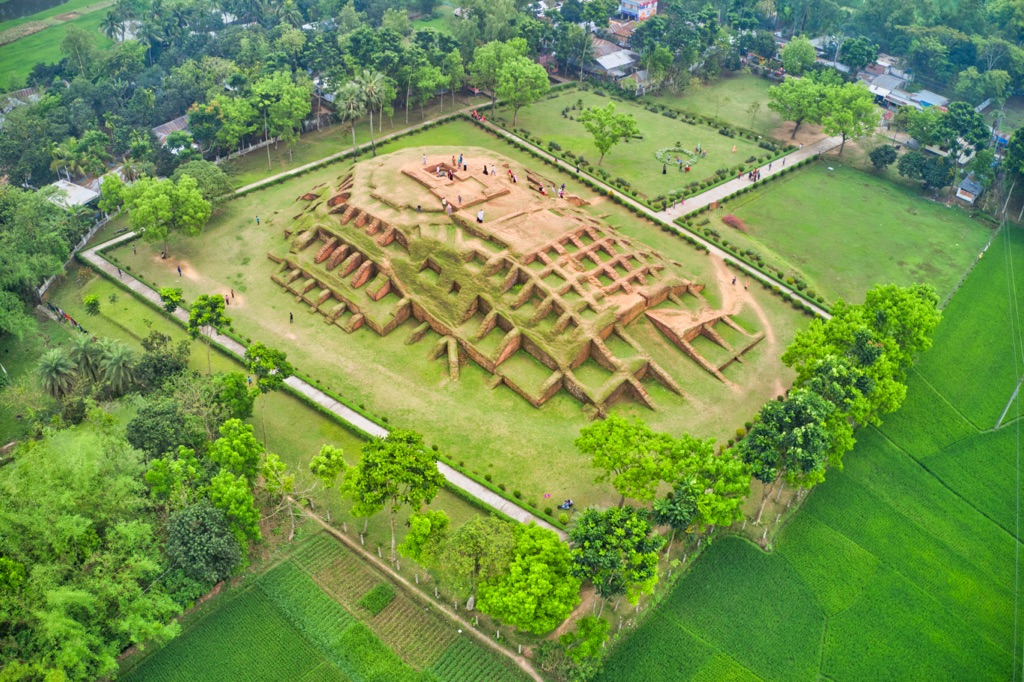Gokul Medh, also known as Lokma Rajar Dhibi, is a historical site located in Bangladesh. It is an ancient archaeological site that bears the remnants of past civilizations. The site is particularly significant for its Buddhist vihara, which dates back to between the 6th and 12th centuries AD. The mound on which Gokul Medh stands is a testament to the architectural prowess of ancient builders and the rich cultural heritage of the region.
Get your dose of History via Email
Historical Background of Gokul Medh
Discovered in the early 1930s, Gokul Medh is an intriguing archaeological site. A local landlord, named Gokul, unearthed it while building a house. The site’s excavation began in 1934 under the guidance of archaeologist K.N. Dikshit. Further excavations in the 1960s brought more details to light. The site is believed to have been built by the Mauryan emperor Ashoka in the 3rd century BC. However, most of the remaining structures date to the Gupta period.
Over the centuries, Gokul Medh has seen various inhabitants. The site was initially a Buddhist monastery. Later, it became a Hindu temple complex. This transition reflects the changing religious dynamics of the region. The site also witnessed significant historical events. For instance, it was a center of learning and culture during the Pala Empire.
The builders of Gokul Medh remain a subject of study. While Ashoka’s involvement is noted, the Gupta and Pala empires significantly shaped the site. The architectural styles present at Gokul Medh suggest influences from these periods. The site’s strategic location near the Mahasthangarh citadel also points to its historical importance.
Despite its age, Gokul Medh has withstood the test of time. The site has survived invasions, natural disasters, and the ravages of time. Its resilience is a testament to the skill of its ancient builders. Today, Gokul Medh stands as a symbol of Bangladesh’s rich archaeological heritage.
Historically, Gokul Medh has been more than just a religious site. It was a hub of social and cultural activities. The site has hosted fairs, gatherings, and scholarly debates. Its historical significance is not only in its construction but also in the role it played in the lives of people throughout the ages.
About Gokul Medh
Gokul Medh is a complex of ruins that showcases the architectural brilliance of ancient times. The site consists of a large mound, which is the central feature. Excavations have revealed a cruciform structure at the core, surrounded by cells that likely housed monks. The mound is about 5 meters high, with a base measuring approximately 45 square meters.
The construction of Gokul Medh involved the use of baked bricks, a common material in ancient South Asian architecture. The bricks were laid in a diagonal pattern, which added strength to the structure. The use of sand and lime as mortar was also prevalent. This combination has contributed to the longevity of the ruins.
Architectural highlights of Gokul Medh include its stupa-like shape and the intricate designs on some of the bricks. The site’s layout suggests a well-planned monastic complex. The central shrine was likely used for religious ceremonies, while the surrounding cells provided living quarters for monks.
Despite the ruinous state, the remnants of Gokul Medh offer insights into the architectural styles of the time. The site’s design reflects a blend of indigenous and foreign influences. This mix is characteristic of the region’s architecture during the Gupta and Pala periods.
Today, Gokul Medh stands as a silent witness to the past. Its ruins continue to fascinate archaeologists and historians. The site offers a glimpse into the construction techniques and architectural preferences of ancient South Asian civilizations.
Theories and Interpretations
Several theories surround the purpose and significance of Gokul Medh. The most widely accepted view is that it was a Buddhist monastery. This theory is supported by the site’s layout and the discovery of artifacts related to Buddhism. However, some believe it may have also served as a Hindu temple at some point.
The mysteries of Gokul Medh extend to its name. ‘Medh’ means mound in Bengali, which is straightforward. But ‘Gokul’ is more enigmatic. Some suggest it refers to the landlord who discovered the site. Others believe it has mythological connections to the pastoral deity Krishna’s childhood home.
Interpretations of Gokul Medh have had to rely on matching its architecture with historical records. The cruciform structure and monastic cells are typical of Buddhist viharas. Yet, the presence of Hindu motifs suggests a complex religious history. This duality makes Gokul Medh a subject of ongoing research.
Dating Gokul Medh has involved various methods. Carbon dating of artifacts and thermoluminescence dating of bricks have been used. These techniques have helped establish the timeline of the site’s construction and use. They have also aided in understanding the historical context of the region.
Theories about Gokul Medh continue to evolve as new discoveries are made. Each finding adds a piece to the puzzle of this ancient site. The interpretations of Gokul Medh are as complex as its history, reflecting the diverse cultural influences that have shaped it.
At a glance
Country: Bangladesh
Civilization: Mauryan, Gupta, and Pala empires
Age: 3rd century BC to 12th century AD
Conclusion and Sources
Reputable sources used in creating this article:
- Wikipedia – https://en.wikipedia.org/wiki/Gokul_Medh

